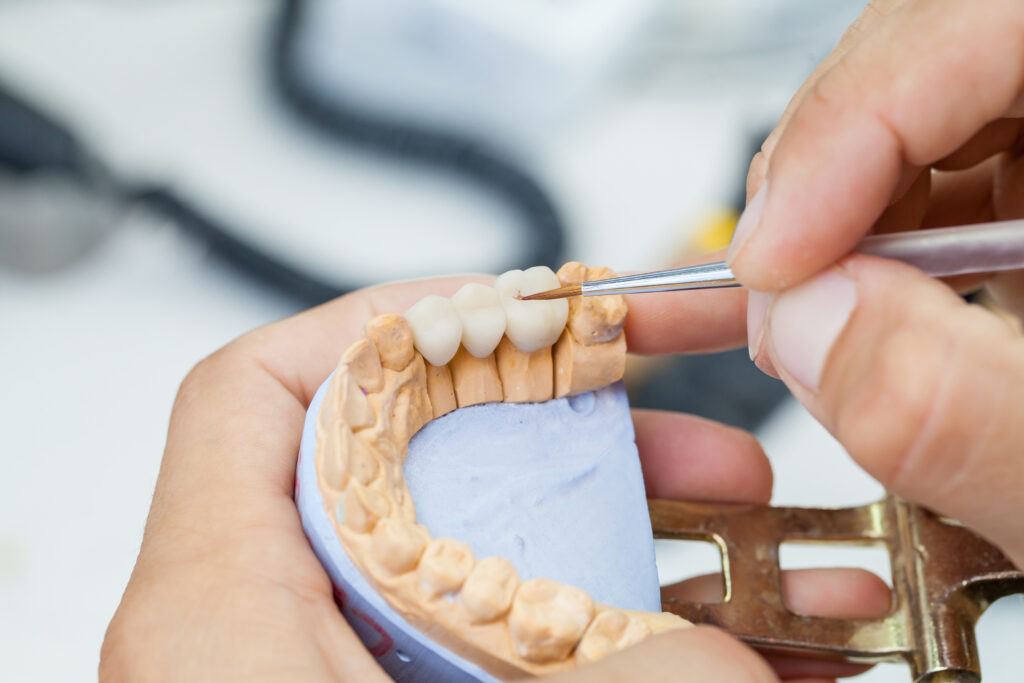Your smile is an essential aspect of who you are, radiating attractive qualities like confidence and warmth. Missing teeth, however, throws off this delicate balance, and it can lead to discomfort and awkwardness.
Fortunately, there are many options available in contemporary dentistry for filling in those spaces and bringing back your smile’s shine. Receiving dental bridges near you can help you regain your beautiful smile and restore its functionality.
- Traditional Dental Bridges
Most patients who are missing teeth choose traditional dental bridges to restore their smile. Dental crowns are cemented onto the teeth next to the abutment teeth, thereby creating a bridge between the two. Crowns are bonded to the teeth on either side of the space to ensure the health of those teeth and the support of the pontic(s). Replacement of a single missing tooth or a set of teeth in close proximity can be accomplished with a traditional bridge.
- Cantilever Bridges
Cantilever bridges are similar to regular bridges. However, they are anchored differently. A cantilever bridge, rather than using two adjacent teeth as abutments, relies on just one healthy tooth to support the pontic(s). This bridge type is commonly utilized when there is just one suitable natural tooth adjacent to the gap.
- Maryland Bridges
Maryland bridges, also known as resin-bonded or adhesive bridges, are a low-cost alternative to conventional bridges. They are often employed to replace missing front teeth and are made up of a metal or porcelain framework to which artificial teeth are affixed. These unique bridges, unlike regular bridges, do not necessitate the removal of enamel from neighboring teeth for crown insertion. They are instead glued to the backs of the surrounding teeth with a powerful dental adhesive.
- Implant-Supported Bridges
Bridges supported by implants are a highly solid and long-lasting method for restoring several missing teeth. Dental implants, which are surgically implanted into the jawbone to simulate natural tooth roots, support this type of bridge. Following the integration of the implants with the bone, a bridge is affixed to the implant abutments. These bridges are a long-lasting and aesthetically beautiful alternative because they provide optimal functionality and prevent bone loss in the jaw.
What Happens During a Dental Bridge Treatment?
A dental bridge is a multi-step process that requires several visits to our dentist. Here’s a rundown of what happens during the appointment:
Step 1: The Initial Consultation
The process usually starts with a consultation with our dentist. Our dentist will assess your oral health during this session, including the status of the teeth closest to the gap created by the missing tooth or teeth.
Step 2: Treatment Planning
If a dental bridge is determined to be an appropriate choice, our dentist will review the many types of bridges available and assist you in selecting the one that best matches your needs and budget.
Step 3: Tooth Preparation
Traditional bridges and cantilever bridges require tooth preparation in the majority of situations. This entails reshaping and shrinking the surrounding teeth that will act as abutments. This ensures that the crowns fit tightly over them.
Step 4: Impressions
Our dentist in Mokena will take imprints of your teeth after the abutment teeth have been created. These imprints are used to make exact molds of your mouth that will be utilized to build the dental bridge.
Step 5: Temporary Bridge
While your permanent bridge is being made in a dental laboratory, our dentist may offer you a temporary bridge to preserve your prepared teeth in order to maintain your appearance.
Step 6: Fabrication of the Dental Bridge
The imprints and dimensions can be sent to a dental laboratory, where expert professionals will create your personalized dental bridge. The bridge will be made to blend in with your natural teeth and bite.
Step 7: Fitting and Adjustments
When the permanent bridge is complete, you will return to our dentist for its installation. The dentist will examine the bridge’s fit, shape, and color. To get a comfortable and natural-looking outcome, adjustments may be performed.
Step 8: Permanent Bridge Placement
When you and our dentist are both satisfied with the fit and aesthetics of the bridge, it will be securely cemented or bonded in place. The pontic (fake tooth or teeth) will cover the space left by the missing tooth or teeth, and the crowns on the abutment teeth will hold the bridge in place.
Step 9: Final Adjustments
Any final adjustments will be made by our dentist to ensure that your bite is even and comfortable with the new bridge in place.
Step 10: Post-Treatment Care
Our dentist will explain how to care for your dental bridge, including correct oral hygiene and any food restrictions. Regular dental check-ups are required to monitor the condition of the bridge and overall oral health.
What are the Advantages of Dental Bridges?
- Bridges fill the gap left by missing teeth, restoring your smile’s appearance and function.
- Improved chewing and speaking abilities.
- Bridges are fixed in place, providing stability and preventing neighboring teeth from shifting.
- Enhanced aesthetics and improved self-confidence.
- Generally more affordable than implants.
- It is faster than some alternatives like dental implants.
- Minimal alteration of adjacent teeth in certain bridge types.
- Bridges can last many years with proper care.
How Long Does it Take to Recover?
It normally takes a few days to a week to recover from a dental bridge treatment. You can experience some slight discomfort or irritation at first, but this should pass promptly. Following our dentist’s recommendations is very important for a quick and painless recovery.
Typically, the entire process takes several weeks and consultations to verify that the bridge fits completely and functions well. After the treatment, you will have a restored smile and better oral function, which will make daily activities like eating and speaking more comfortable and enjoyable.
Visit Axion Dental to Restore your Smile!
Our knowledgeable staff is committed to providing you with a comfortable and satisfying experience. We’ll help you bridge the gaps in your smile with our expertise, assuring both efficiency and appearance. Trust us to restore your smile’s brilliance and your confidence in it.
Book your appointment today!


